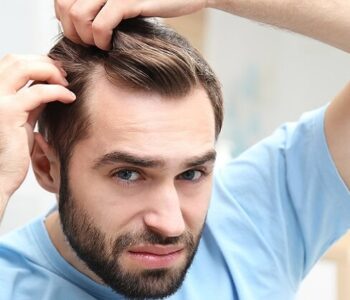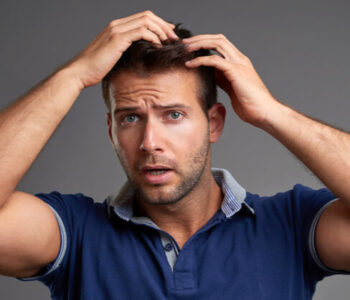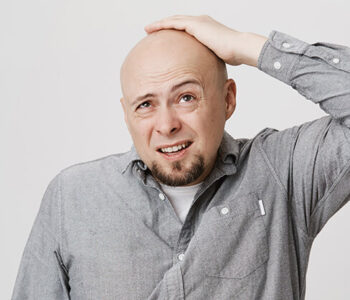In 30 seconds…
Finasteride (also known as Propecia) and Minoxidil (also known as Regaine) are two of the most effective treatments for hair loss on the market today.
Finasteride is an oral tablet which blocks the hormone responsible for hair loss. It’s widely recommended as the first port of call for men dealing with Male Pattern Baldness.
Minoxidil, meanwhile, is a topical solution designed to promote new hair growth and improve hair density.
Finasteride vs Minoxidil: What’s the Difference?
Finasteride and Minoxidil are both effective treatments for hair loss (otherwise known as Male Pattern Baldness, or MPB), but they work in very different ways.
In essence, Finasteride (an oral tablet) stops hair loss, while Minoxidil (a topical solution) promotes new growth. If you want to know which is right for you, you first need to grasp how they work and what sort of results they get.
Let’s explore this in a little more detail:
How Does Finasteride Stop Hair Loss?
To understand how Finasteride works, you need to know about Dihydrotestosterone (DHT). In short, DHT is an androgen (male sex hormone) which is largely responsible for hair loss.
Finasteride, a 5α-reductase inhibitor, blocks testosterone from being converted into DHT. This, in turn, stops DHT from binding to your hair follicles, which would cause them to shrink and thin (a process called “miniaturisation”).
It’s important to note that this isn’t a “one and done” hair loss solution. DHT is only blocked so long as the Finasteride remains active in your body, and it can take between 6 to 9 months to see results. If you stop taking it, the testosterone to DHT conversion will start up again — as will your hair loss.
How Does Minoxidil Help Hair Growth?
As with Finasteride, to understand how Minoxidil works, it’s helpful to know a little bit about the science that underpins it. And that means getting to grips with the hair growth cycle.
The cycle can be broken down into four parts:
- The Growing Phase (Anagen): Healthy hair grows around half an inch a month during this phase, which typically lasts between 2 and 5 years on average — and occasionally much longer.
- The Transition Phase (Catagen): This is a short transition stage which signals the end of active hair growth. It lasts around 10 days.
- The Resting Phase (Telogen): The newly grown hair rests in the follicle until it’s pushed out by the growth of a new hair. This phase lasts around 3 months for the hairs on your scalp.
- The New Hair Phase (Exogen): During this final phase, the old hair detaches and falls out, while the new hair continues to grow. The entire cycle is then repeated.
By applying Minoxidil directly to the scalp 1 to 2 times daily, it widens the blood vessels and allows more oxygen and nutrients to reach the hair follicles via the blood.
And by doing so, it promotes hair growth by causing the hairs in the resting phase to shed, replacing them with new hairs in the growing phase. This is why you may experience an initial rapid hair loss as a side effect of Minoxidil — but don’t worry, this is just an early indication that it’s working!
Time and Persistence Are Key
In order for Minoxidil to work, time and persistence are vital factors. It’s not an overnight miracle cure. Rather, it requires discipline and patience.
It may take around 3 to 6 months before you notice any real effect on the density or coverage of your hair. And, as with Finasteride, when you stop using Minoxidil, the benefits will stop too — usually within 4 to 6 months. For best results, build it into your daily routine.
Do Finasteride and Minoxidil Get Results?
Yes! When used regularly and as directed, both Finasteride and Minoxidil offer encouraging results for anyone looking for an effective hair loss treatment.
How Effective is Finasteride?
A 2003 study found that 83% of participants experienced no further hair loss, while a 2012 study involving 2,500 men observed that 87% experienced greater hair growth thanks to the treatment.
Meanwhile, the results of three five-year studies, involving a total of almost 6,000 patients, showed that hair loss was stopped in 90% of men, with 77% enjoying increased hair growth.
And What About Minoxidil?
Just as Finasteride is scientifically proven to stop hair loss, Minoxidil is also backed by a number of positive studies in the hair growth stakes:
- One four-month study found that 74% of men considered Minoxidil to have improved their hair density.
- Meanwhile, another study determined that around 60% of patients treated with a 5% solution enjoyed increased scalp coverage after 48 weeks of daily use.
- And, by comparing the 5% solution to the 2% equivalent, a 2002 study found that men treated with the 5% had approximately 45% more regrowth at week 48 than those using the 2%.
Finasteride vs Minoxidil: Which Is Best?
A 2004 comparison study put Finasteride and Minoxidil head-to-head. Finasteride emerged victorious, the more effective of the two.
However, the same study notes that both are safe and get results.
“So, Do I Choose Finasteride or Minoxidil?” — Why Not Both?
Ultimately, choosing between Finasteride and Minoxidil will come down to any number of factors, including your personal circumstances, expectations, age, budget, desired time frame, and more.
After all, these are demonstrably different medications, designed with different goals in mind. One stops hair loss at its source, while the other gets to work topically to promote growth.
And because Finasteride addresses MPB by inhibiting DHT production, many hair loss experts suggest that you start at the root cause before tackling regrowth.
However, if Finasteride is Batman, then Minoxidil is Robin.
And this dynamic duo works best together to stop hair loss in its tracks and stimulate new hair growth at the same time, as evidenced by a 2002 study published in the Journal of Dermatology.
Furthermore, given that Finasteride and Minoxidil work in different ways — and target different areas of the body — there’s no risk in taking them together.
In Summary
Tackling hair loss is a commitment. Whether you choose Finasteride or Minoxidil, if you use them as instructed — and have a little patience — chances are you’ll see results.
But if you want to face MPB head-on and cover every base, a combination hair loss treatment could be the way to go.











